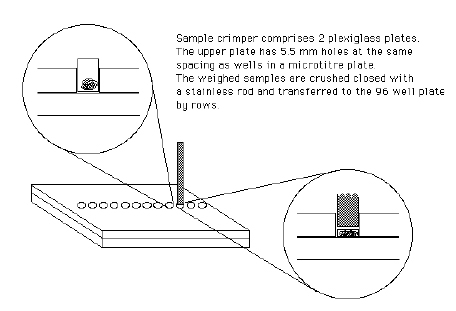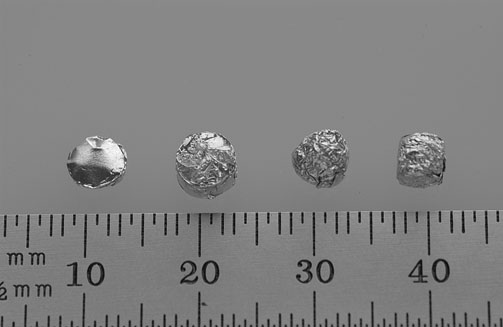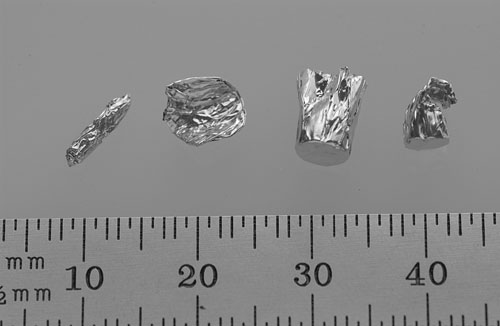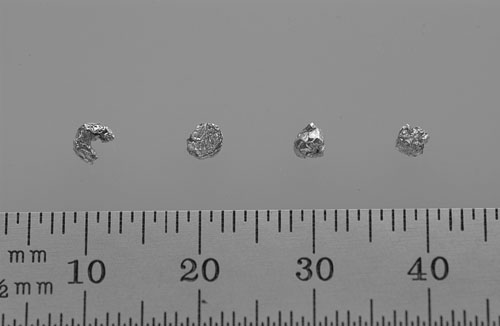Sulfur (34S) Tips
-The SIF does not currently offer 34S analysis of soils, sediments, or wood. Clients interested in 34S analysis of these materials should contact us.
-Please note, GF/F filter material cannot be run on the sulfur instrument, avoid/remove all particles of filter prior to sample encapsulation.
-Record your sample weight on your Sample List. The sample weight is of your sample material only; do not include the weight of the tin.
-During weighing, if you find your samples to be sticky, try drying the material more.
How to encapsulate samples
Please encapsulate solid samples in tin capsules so they remain intact and do not leak and contaminate other samples during shipping. Test your crimping-sealing method using a dummy sample in a tray. Shake and flip the tray to mimic agitation during shipping to see if the sample stays in its well or leaks from the tin. Very small or flat samples can escape their wells during shipping by slipping through the gap between the tray and cover. Do not underestimate the gap between the tray and cover! This is the number one cause of lost samples.
You can make a crimper plate (pictured below) to hold tins and use a metal dowel to compress them in the plate holes. Once compressed, the closed samples can be transferred directly into a 96-well tray.

Alternatively, you can manually seal the tins using two sets of forceps with blunt tips to form them into cubical or cylindrical shapes. First, pinch the top closed and fold it over. Then, press and hold the capsule top to bottom while using the other forceps to pinch the sides inward. Repeat until you have a compact tightly packed tin.
|
Do...
|
Don't...
|
| - Crimp samples into a compact spherical, cylindrical, or cubic shape, with maximum dimensions of 6 mm for 5x9 mm tins. - Make sure tin capsule openings are folded over more than once if you can't fully compress the samples. - Place an index card over the tray before securing the cover if you have small samples. - Use clean equipment to handle the samples and tins. |
- Don't shape your samples into very flat disks (<1 mm) or thin tube/cigar shapes. - Don't ship capsules that only have their openings pinched closed or folded once. - Don't ship samples that are leaking. - Don't over-fill capsules. - Don't contaminate samples by handling with bare hands or by using sandpaper to grind plant or wood samples. |
 |
 |
| Above are examples of standard sized samples. From left to right: ~ 1 mm tall X 5.5 mm diameter cylindrical sample ~ 4 mm tall X 5.5 mm diameter cylindrical sample ~ 5 mm spherical sample ~ 5 mm cubical sample |
Above are examples of improperly shaped samples. From left to right: - The opening of this capsule has only been folded over one time. |
 |
|
| Above are examples of very small and compact samples which can slip between the gap that is manufactured into all 96-well trays. Use an index card to cover the tray before taping on the cover. From left to right: ~ 1 mm tall X 3 mm wide crescent shaped sample ~ 1 mm tall X 3 mm wide cylindrical sample ~ 3 mm spherical sample ~ 2.5 mm cubical sample. |
Avoid contaminating your samples with packing materials
-Do not wrap or cushion your individual samples with Kimwipe tissue or cotton wool when placing samples in a 96-well plate. Tissue and cotton particles may contribute sulfur.
-Do not mark your samples with ink or pencil for ID purposes. Ink and pencil may contribute sulfur.
-Do not place loose desiccant in direct contact with your 96-well plate. The resulting dust will contaminate your samples. Dessicant should be self-contained and separate from your 96-well plate.
-Do not place adhesive tape or Parafilm directly over wells in a 96-well plate. The adhesive will transfer onto your samples causing them to stick to our autosampler and will result in sample loss. If you must close the gap between the 96-well plate and cover, trim an index card to size and place the index card between the plate and cover.
Shipping
Please read and follow the instructions carefully to ensure safe transit and appropriate handling of your samples.
1) Please complete the online Analysis Order Form and Sample List for your samples and email these forms to sif@ucdavis.edu. Please include a printed copy of these forms with your samples. The SIF uses this form to track your samples and to contact you regarding receipt of samples, data, and invoicing. For mixed analysis requests, we require the completion of a separate form for each type of analysis.
Also, please include:
-A specific description of each sample, including freshwater vs. seawater species and approximate elemental composition.
-The expected range of isotopic composition of enriched material.
The sample list should include the weight of the sample material, not including the tin. If more rows are required in the sample list, simply add the rows and continue the numbering in column A.
2) Carefully package the sample trays to protect them during shipping. Single trays should be wrapped with multiple layers of bubble wrap and can be shipped in a padded envelope or box. Multiple trays should be banded or taped together and shipped in rigid box filled with packing material. Desiccants, such as Drierite, should not be included with samples unless contained within a spill-proof, separate package.
Failure to properly package and protect trays often results in sample loss during shipping.